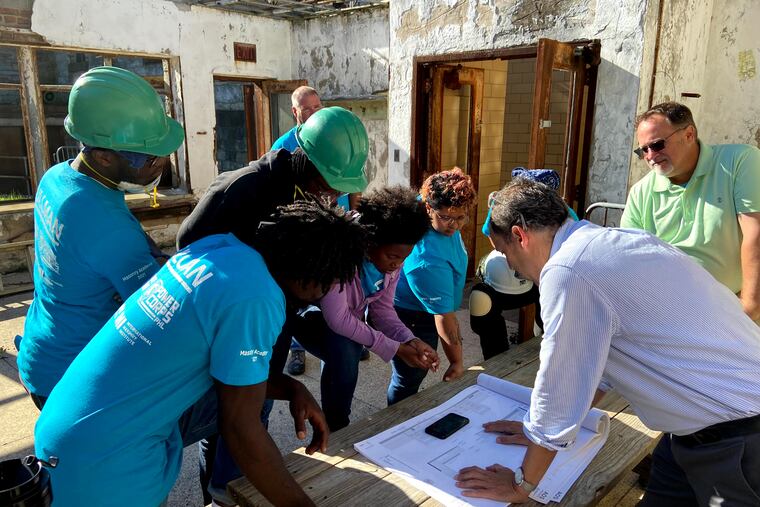Eastern State Penitentiary turned its ‘stabilized ruin’ into a classroom for historic preservation
For formerly incarcerated Philadelphians, Eastern State Penitentiary’s new Preservation Trades Center offers paid on-the-job training and a path to union employment.

After years of watching her mother’s front steps slowly crumbling into the street, Tynerra Brown knew masonry was a skill her community direly needed — and a trade that came with the potential of coveted union jobs.
But when she found out her path to learning the trade ran through a prison, her first reaction was horror.
“Terror Behind the Walls? I was scared!” said Brown, 28.
Now, though, Brown sees helping restore a crumbling wall at Eastern State Penitentiary as one more way to serve both her community and her career goals, while helping stabilize a Philadelphia historic site.
She’s part of the masonry academy, the first program of a new workforce development initiative called the Eastern State Penitentiary Preservation Trades Center that provides paid preservation training for formerly incarcerated people, women, and people of color.
Since most of the museum is considered a stabilized ruin — and about 30% of the 11-acre property is still entirely untouched by preservation crews — there are plenty of opportunities for on-the-job training, said Liz Trumbull, manager of historic preservation and architectural conservation.
“Watertight and safe are two objectives,” she said, though some select spaces are being fully and painstakingly restored. “We restore spaces to the extent that it benefits our historical mission or the space demands it.”
ESP — which has prioritized hiring formerly incarcerated people in recent years, and run programming in Pennsylvania state prisons — developed the academy in collaboration with PowerCorpsPHL, the city’s Rebuild initiative, and the International Masonry Institute.
» READ MORE: A Philly jobs program lost six to a year of violence. Can it still help young people thrive?
Pullman, a general contractor, is also a partner, providing on-site training, apprenticeship opportunities for academy graduates, and, for those who succeed, admittance into the union.
The first obstacle to that career goal, on a recent morning, was a towering stone wall.
ESP has been expanding downward, burrowing out spaces to improve accessibility and to funnel visitors toward what will one day be a new visitor center that will include such luxuries as flushing toilets. The masonry students needed to rebuild and repoint those newly exposed stones, thereby stabilizing the wall.
Dan Organ, a senior estimator at Pullman who helps run the academy, said he could see the beauty in their steady work along the wall. He tells the students to take pride in its prime placement near the entrance. “Normally, you get an apprentice, you put them at work in a wall nobody sees!”
The program also includes guest lectures, offering introductions to fields including brick-laying and conservation.
On one recent early morning, Andrew Fearon, an architectural conservator who helped restore the prison’s synagogue, showed the students how his team reconstructed the historical design, replicating plaster molding and puzzle-piecing fragments of vinyl floor tiles into place.
“Now, let’s talk about cement!” he continued enthusiastically. He finished with a plaster demonstration, mentioning one tradesman known to grow out his fingernails so he could rough up his “scratch coats” by hand. (“Oh, he different!” one student remarked.)
Brown said she was intrigued by the career possibilities presented, including brick-laying, which she sees as a complement to her interests in masonry and landscaping.
For Organ, it’s a way to close what he sees as a troubling generational gap in young skilled workers.
“We wanted to get students involved in the trades, in the hopes of hiring some of them on so they can make a career out of it,” he said.
In a year of worker shortages, the program was in demand, according to PowerCorpsPHL executive director Julia Hillengas.
“They’re looking for that job security,” she said. “They’re also from communities that typically don’t have access to unions, so having Pullman as a union employer come to the table is huge.”
Only the top students will get that opportunity, and Brown wants in. And she said after seeing the Halloween decorations in the daylight, she’s no longer fearful.
“It’s pretty cool to help fix the structure so it can stay a little longer,” she said.